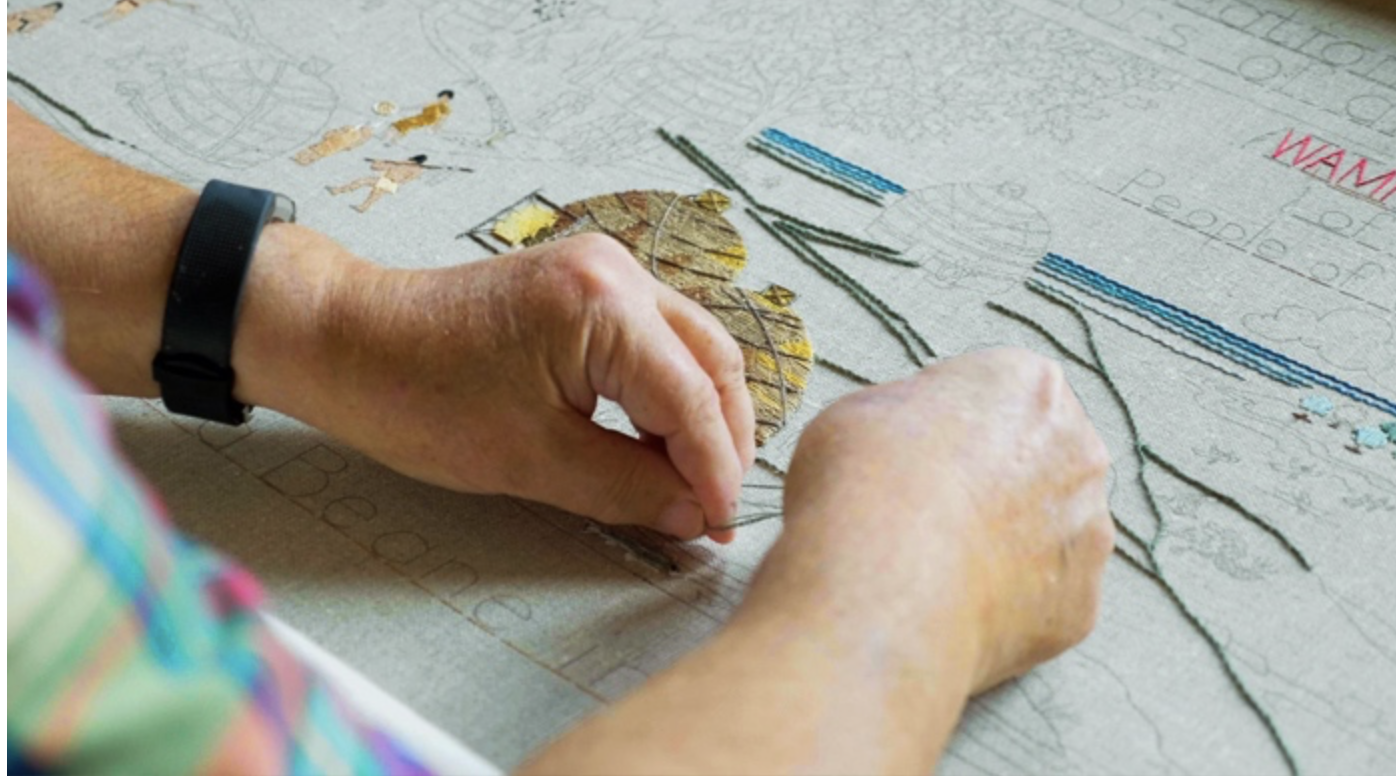Almost almost everyone will know of the Bayeux Tapestry, an enormous embroidered frieze which recorded the events of the Norman Conquest and the Battle of Hastings in 1066. But the Bayeux Tapestry is not the only piece of epic embroidery undertaken to commemorate a major event.
In the city of Plymouth in Massachusetts, USA, a team of dedicated embroiderers and historians decided to create something to rival the Bayeux Tapestry in order to mark the 400th anniversary of the pilgrim’s arrival on their on the shores in 1620.

Putting stitches into one of the early panels.
The final design will consist of 20 panels each measuring 6 feet in length.
Right from the outset there was recognition that the project had to tell two stories. Although the pilgrims had arrived on the Mayflower in November 1620, the land they arrived on was not uninhabited. The Wampanoag people had lived on the land for thousands of years and their history was a fundamental part of local lore.
As such, a number of historical contributors were recruited to determine the narrative of each panel, the most appropriate imagery to tell the story, and the total timeline to be displayed

A panel with threads and wools selected. and example stitches sourced. (source).
Elizabeth Creeden, a talented local needlework designer, was appointed to make the drawings and plan the embroidery for each panel. This required research, consultation and many preliminary drawings. Elizabeth would work on one panel at a time, finally making a drawing to scale on paper the same size as the linen it was to be printed on.

Elizabeth Creeden at work (source).
This drawing would then be sent to Trustworth Studios who printed it on the linen – no easy task. Although when the first panels started coming back, the accuracy of the print was such that there only a variation of a single thread across the entire 6 feet!
As you can imagine, completing such a project would mean thousands and thousands of stitching hours.
But right from the start it was determined that the stitching would be a communal task. Over the years since the project started, panels have been taken to conferences, workshops and meetings to allow all members of the public to contribute.
Embroidery has been done by children and adults, women and men, highly experienced embroiderers and people who have just started out. Although guidance was given to maintain a standard of quality across the peace, Elizabeth Creeden deliberately designed each panel with stitches simple enough that anyone could learn how to do them and play their part.

Stitchers working together. (source).
Although the opportunity to attend the public workshops have now passed, there are still panels being worked on with the entire project expected to be completed and assembled in 2021
While the celebration date for the 400th anniversary of the Mayflower is in November 2020 a lot of the story of the pilgrims survival occurred in 1621 so the time scale is still on track.
A number of the completed panels will be on display as the November celebrations get closer. But the final, completed tapestry will be the one to see once it’s all put together.

A completed panel (source).
Not only will the completed tapestry tell the story of the pilgrims, the Wampanoag people and the development of the area, but it will create a memorial which is sure to still be admired in 1000 years time, just as the Bayeux Tapestry is today.
To read more about this amazing project, you can read an article in the Embroiderer’s Guild of America or check out the Pilgrim Hall Museum and website.
Reprinted from Inspirations Newsletter news@inspirationsstudios.com
This electronic newsletter is published every Friday and originates from Australia.
Contact them to be on their emailing list. Always interesting content.
Leave a Reply